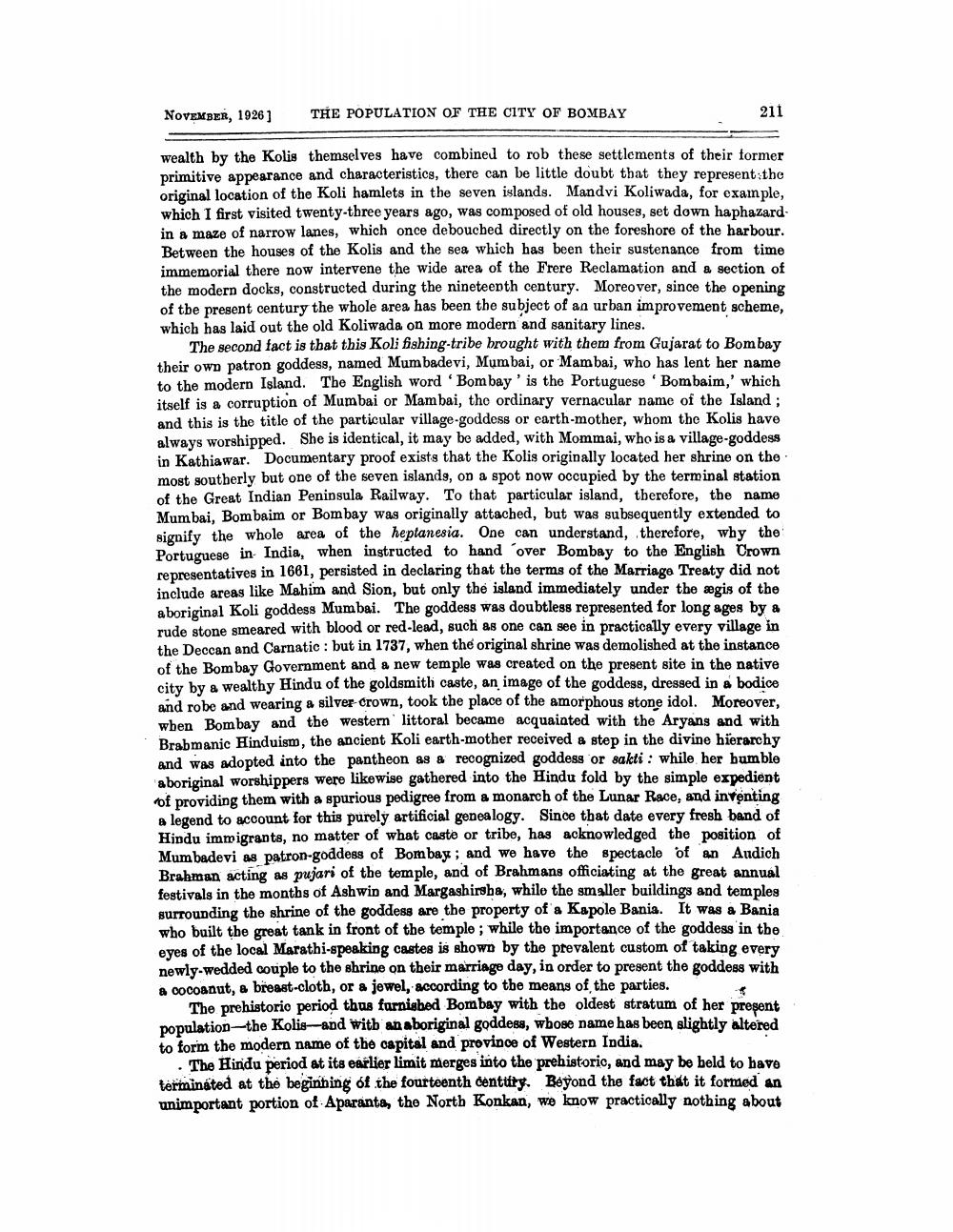________________
NOVEMBER, 1926 ]
THE POPULATION OF THE CITY OF BOMBAY
211
wealth by the Kolis themselves have combined to rob these settlements of their former primitive appearance and characteristics, there can be little doubt that they represent the original location of the Koli hamlets in the seven islands. Mandvi Koliwada, for example, which I first visited twenty-three years ago, was composed of old houses, set down haphazardin a maze of narrow lanes, which once debouched directly on the foreshore of the harbour. Between the houses of the Kolis and the sea which has been their sustenance from time immemorial there now intervene the wide area of the Frere Reclamation and a section of the modern docks, constructed during the nineteenth century. Moreover, since the opening of the present century the whole area has been the subject of an urban improvement scheme, which has laid out the old Koliwada on more modern and sanitary lines.
The second fact is that this Koli fishing-tribe brought with them from Gujarat to Bombay their own patron goddess, named Mumbadevi, Mumbai, or Mambai, who has lent her name to the modern Island. The English word 'Bombay' is the Portugueso 'Bombaim,' which itself is a corruption of Mumbai or Mambai, the ordinary vernacular name of the Island ; and this is the title of the particular village-goddess or earth-mother, whom the Kolis have always worshipped. She is identical, it may be added, with Mommai, who is a village-goddess in Kathiawar. Documentary proof exists that the Kolis originally located her shrine on the most southerly but one of the seven islands, op a spot now occupied by the terminal station of the Great Indian Peninsula Railway. To that particular island, therefore, the name Mumbai, Bombaim or Bombay was originally attached, but was subsequently extended to signify the whole area of the heplanesia. One can understand, therefore, why the Portuguese in India, when instructed to hand over Bombay to the English Crown representatives in 1661, persisted in declaring that the terms of the Marriage Treaty did not include areas like Mahim and Sion, but only the island immediately under the agis of the aboriginal Koli goddess Mumbai. The goddess was doubtless represented for long ages by a rude stone smeared with blood or red-lead, such as one can see in practically every village in the Deccan and Carnatic : but in 1737, when the original shrine was demolished at the instance of the Bombay Government and a new temple was created on the present site in the native city by a wealthy Hindu of the goldsmith caste, an image of the goddess, dressed in a bodice and robe and wearing a silver crown, took the place of the amorphous stone idol. Moreover, when Bombay and the western littoral became acquainted with the Aryans and with Brabmanic Hinduism, the ancient Koli earth-mother received a step in the divine hierarchy and was adopted into the pantheon as & recognized goddess or sakti : while her bumble aboriginal worshippers were likewise gathered into the Hindu fold by the simple expedient of providing them with a spurious pedigree from a monarch of the Lunar Race, and inventing a legend to account for this purely artificial genealogy. Since that date every fresh band of Hindu immigrants, no matter of what caste or tribe, has acknowledged the position of Mum badevi as patron-goddess of Bombay; and we have the spectacle of an Audich Brahman acting as pujari of the temple, and of Brahmans officiating at the great annual festivals in the months of Ashwin and Margashirsha, while the smaller buildings and temples Burrounding the shrine of the goddess are the property of a Kapole Bania. It was a Bania who built the great tank in front of the temple ; while the importance of the goddess in the eyes of the local Marathi-speaking castes is shown by the prevalent custom of taking every newly-wedded couple to the shrine on their marriage day, in order to present the goddess with a cocoanut, a breast-cloth, or a jewel, according to the means of the parties.
The prehistorie period thus farnished Bombay with the oldest stratum of her present population--the Kolis--and with an aboriginal goddess, wbose name has been slightly altered to form the modern name of the capital and province of Western India.
The Hindu period at its earlier limit merges into the prehistoric, and may be beld to have terminated at the beginning of the fourteenth century. Beyond the fact that it formed an unimportant portion of Aparanta, the North Konkan, we know practically nothing about




